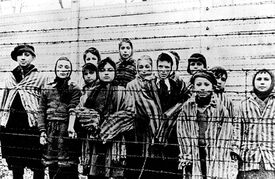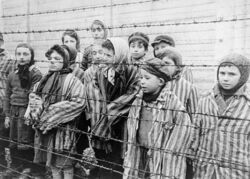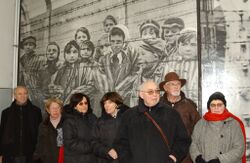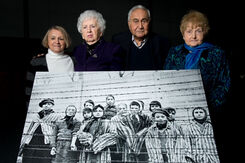Shmuel Schelach / Robert Schlesinger (M / Slovakia, 1934-2006), Holocaust survivor
Shmuel Schelach / Robert Schlesinger (M / Slovakia, 1934-2006), Holocaust survivor
Palo Shelah / Pavel Schlesinger (M / Slovakia, 1938), Holocaust survivor
- KEYWORDS : <Auschwitz> <Liberation of Auschwitz> -- <Israel>
Biography
Shmuel Schelach (formerly Robert Schlesinger) was born on 19 January 1934 in Mytna Nova Ves, Czechoslovakia. His parents were Artur and Jolan Schlesinger, and he had one younger brother. In September 1944, Shmuel and his six year-old brother were sent ahead of their parents to a pre-arranged hiding place in the city of Nitra. Their parents planned to join them there, but were caught by the Germans. After wandering from one hiding place to another, without any money to pay those who hid them, Shmuel and his brother were also caught in October 1944. They were sent to the Sered camp, and from there, they were deported to Auschwitz-Birkenau on 31 October 1944.
On their arrival at Birkenau, they waited inside the cattle cars for the Germans to decide their fate. (Everyone on the previous transport had been sent to the gas chambers). In the late afternoon, they were brought down from the cars, and contrary to the usual procedure, they did not undergo selection, but were taken inside Birkenau with their belongings. “From there on” says Schelach “it was pure luck.” They were able to see their mother twice, through the barbed wire fence, before she was sent on a death march from Auschwitz to Bergen Belsen.
Shmuel and his brother were liberated by the Red Army on 27 January 1945. His younger brother Palo Shelah is present in an iconic Auschwitz picture, that depicts 13 child survivors, shortly after the liberation of the camp.
After the war, they were in an orphanage in Czechoslovakia, where they were eventually reunited with their father. Shmuel emigrated to Israel in 1949, where he became a technician. Today he lives in Nahariyya, married with 2 children.
Auschwitz Picture
He is present in an iconic Auschwitz picture, that depicts 13 child survivors, shortly after the liberation of the camp. All of them have been identified. From left to right they are:
- (1) Tomy Shacham / Tomy Schwarz (M / Slovakia, 1933)
- (2) Miriam Friedman / Miriam Ziegler (F / Poland, 1933)
- (3) Pessa Balter / Paula Lebovics (F / Poland, 1933)
- (4) Ruth Muschkies / Ruth Webber (F / Poland, 1935)
- (5) Bracha Katz / Berta Weinhaber (F / Slovakia, 1930)
- (6) Erika Dohan / Erika Winter (F / Czechia, 1931)
- (7) Marta Wise / Marta Slonim (F / Slovakia, 1934)
- (8) Eva Slonim / Eva Weiss (F / Slovakia, 1931)
- (9) Gabor Hirsch (M / Poland, 1929)
- (10) Gabriel Neumann / Gabriel Nejman (M / Czechia, 1937-2012)
- (11) Shmuel Schelach / Robert Schlesinger (M / Slovakia, 1934-2006)
- (12 & 13) Eva & Miriam Mozes / Eva Kor (F / Romania, 1934-2019) and Miriam Zieger (F / Romania, 1934-1993).
Shmuel Schelach was among the seven children who reunited on 27 January 2005 in the ceremony in Poland marking 60 years since the liberation of Auschwitz (photograph by Dalit Shacham). The group included (from left to right): Tomy Shacham (1); Erika Dohan (6); Marta Wise (7); Eva Slonim (8); Shmuel Schelach (11); Gabriel Neumann (10); and Bracha Katz (5).
In separate reunion four other survivors gathered in Krakow, Poland on 26 January 2015, at the invitation of the USF Shoah Foundation, on the eve of the 70th anniversary of the liberation of the death camp. The Group included (from left to right): Paula Lebovics (3), Miriam Ziegler (2), Gabor Hirsch (9), and Eva Kor (12). (Photo by Ian Gavan/Getty Images).
USF Shoah Foundation
Shmuel Schelach (born Robert Schlesinger) was one of the very few who managed to survive the Holocaust with his immediate family intact ...
Born Jan. 19, 1934 in Mytna Nova Ves, Czechoslovakia, Shmuel lived with his mother, father – who managed agricultural farms – and brother Palo, who was four years younger. During the first wave of transports of Czech Jews to concentration camps in 1942, Shmuel’s family tried to cross the border into Hungary, but did not succeed. Since they could not go back home, they rented an apartment in Nitra, Czechoslovakia, and Shmuel’s father began working in a brick factory. The manager of the factory was not a Jew, but he offered to hide the family in the factory in exchange for money.
On September 5, 1944, the family received orders to report to Gestapo headquarters. Early that morning, Shmuel’s mother dressed Shmuel and Palo in warm clothes and instructed them to go ahead to the factory alone – the parents would follow later so as not to arouse suspicion. Shmuel and Palo passed all the German checkpoints and arrived at the factory, but when their parents never arrived the boys knew they must have been caught. After a few days of hiding, the factory manager realized that he was not going to be paid and conditions were getting dangerous so he ordered the children to leave.
Without any idea where else to go, Shmuel and Palo began following the railroad tracks to their grandparents’ house 30 kilometers away. When they arrived, the house was empty. They found shelter with a neighbor for one night and then went to their aunt’s house in another village, where they stayed alone for several weeks. In October, they were caught along with three other Jews in the village by the Slovak militia and sent to the Sered concentration camp, and from there to Auschwitz-Birkenau by cattle car.
Unlike the last transport to arrive at the camp, which had been sent immediately to the gas chamber, Shmuel and the others on the train were allowed inside Birkenau with their belongings. In Birkenau, Shmuel worked with other children collecting garbage. A German guard took a liking to Palo and would bring the boys extra food from time to time and even a warm coat for Palo. Unbeknownst to them, their mother was working in the kitchen at the women’s camp in Auschwitz and another prisoner told her that she saw Shmuel and Palo in the men’s camp. On Christmas Eve, she got some sugar cubes from the kitchen and met the boys at a fence. She threw the sugar cubes over to them, but they fell into the deep snow and the boys couldn’t find them.
On January 18, 1945, the approaching Red Army triggered the Germans to begin sending the majority of the camp to go on death marches to lands that were still under German control. Shmuel, because he looked strong enough, was selected to join the march, but he immediately asked to stay with Palo since he knew they had to stay together. On Jan. 27, the Soviet Army arrived and liberated Auschwitz.
Miraculously, all four members of the Schlesinger family were sent to Auschwitz and all survived. After liberation the family immigrated to Israel in 1949, where Shmuel married his wife Eva Mayer (today Chava Schelach) and had two daughters, Tali and Limor. He was an optimistic person, never vindictive and always willing to share his stories for the rest of his life, Limor says. He passed away on August 29, 2006, from heart disease probably caused by complications from severe arthritis he developed in Auschwitz.



